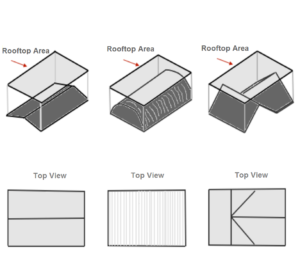This post is also available in: Español (Spanish) Français (French) Deutsch (German)
Rainfall can be collected from any surface. Using a simple rainwater collection calculator, it is possible to find the amount of water that can be collected. Nonetheless, it is important to keep in mind that there are always losses when collecting/storing rainfall, such as evaporation and/or leakage, in addition to variations that can result from area specific weather conditions. In the following, these elements are not considered, yet they are a useful tool to get a general idea of the quantity of rainfall that can be collected.
This first rainwater collection calculator can be used to determine the maximum amount that can be harvested in general terms. A simple multiplication will provide the total possible rainfall that can be captured, based on answering the following questions:
- How much does it rain annually?
- What are the dimensions of the catchment area?
Total possible rainfall capture (m3/year) = Precipitation (mm/year) · Dimension of Catchment Area (m2)
Average annual precipitation
| Climate zone | Precipitation rate |
|---|---|
| Desert area | 0-100 mm |
| Semi-desert area | 100-250 mm |
| Arid area | 250-500 mm |
| Semi-arid area | 500-750 mm |
| Semi-humid area | 900-1500 mm |
| Humid tropics | > 2000 mm |
If you would like to discover more about RWH methods, one fun and easy tool is to create a DIY rain-gauge to measure rainfall in your area, or take a look at a rainfall map of the world designed by NASA, to get a better perspective of precipitation levels worldwide. NASA is also looking for support from students, professors and science-enthusiasts, who would like to collect data and support their Global Learning and Observations to Benefit the Environment (GLOBE) Program. Moreover, if you need specific data on precipitation, the UN has created a large database that can come handy.
Rainwater Collection Calculator by Claudia Lasprilla Pina, Mykyta Riabchynskyi, Rahel Birhanu Kassaye and Ruth Schaldach is licensed under a Creative Commons Attribution-ShareAlike 4.0 International License.
Collecting rainwater from rooftops
The following calculation will help to identify the amount of water that can be collected through rooftops, where the collected rainfall depends on 3 factors:
- Area of run-off (roof area)
- Surface run-off coefficient (depends on run-off area material)
- Amount of precipitation (depends on climate in region)
The area of run-off refers to the footprint of the rooftop. This outline, as shown in the picture, will help to calculate the catchment area by simply multiplying the length by the width, which will provide its total surface; remember to also consider the area of the roof’s overhang when calculating.
Runoff Coefficient for Rooftops
| Roof Pavement Type | Runoff Coefficient |
|---|---|
| Iron Sheets | > 0.9 (assume 1 for cold region, 0.98-0.99 for hot region) |
| Aluminium Sheets | 0.8-0.9 |
| Tiles | 0.6-0.9 |
| Flat Cement Roofs | 0.6-0.7 |
| Organic | 0.2 |

Rooftop Area by Claudia Lasprilla Pina is licensed under a Creative Commons Attribution-ShareAlike 4.0 International License.
Input the information provided in the tables above into the rainwater collection calculator, according to your region and rooftop material. The calculator will provide the solution to the following equation:
Supply of water in the storage tank (m3/year) = Rooftop area (m2) · Runoff coefficient · Precipitation (mm/year)
Rooftop Rainwater Collection Calculator by Claudia Lasprilla Pina, Mykyta Riabchynskyi, Rahel Birhanu Kassaye and Ruth Schaldach is licensed under a Creative Commons Attribution-ShareAlike 4.0 International License.
It may be of interest to you to have a further look at our DIY Rooftop Rainwater Harvesting Handbook, which explains step-by-step how to install a rain catchment system in your own house.



